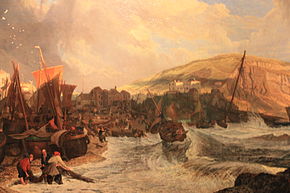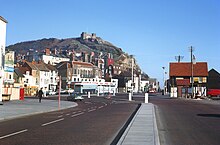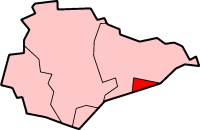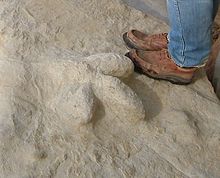
A | B | C | D | E | F | G | H | CH | I | J | K | L | M | N | O | P | Q | R | S | T | U | V | W | X | Y | Z | 0 | 1 | 2 | 3 | 4 | 5 | 6 | 7 | 8 | 9
Hastings
Borough of Hastings | |
|---|---|
| Hastings | |
 View of Hastings Old Town from the East Hill | |
 Borough of Hastings shown within East Sussex | |
| Coordinates: 50°51′N 0°34′E / 50.85°N 0.57°E | |
| Sovereign state | United Kingdom |
| Constituent country | England |
| Region | South East England |
| Historic county | Sussex |
| Ceremonial county | East Sussex |
| Status | Non-metropolitan district |
| Government | |
| • MP | Helena Dollimore MP (Labour Co-op) |
| • Mayor | Margarita O'Callaghan |
| • Borough Council | Julia Hilton, Leader (Green) |
| • County Council | Keith Glazier, Leader (Conservative)[1] |
| Area | |
| • Total | 11.47 sq mi (29.72 km2) |
| • Rank | 301st (of 296) |
| Population (2018) | |
| • Total | 92,855 |
| • Rank | 261st (of 296) |
| • Density | 9,000/sq mi (3,300/km2) |
| Ethnicity (2021) | |
| • Ethnic groups | |
| Religion (2021) | |
| • Religion | List
|
| Time zone | UTC0 (GMT) |
| • Summer (DST) | UTC+1 (BST) |
| Postcodes | |
| Area code | 01424 |
| Website | Hastings Borough Council at www |
Hastings (/ˈheɪstɪŋz/ HAY-stings) is a seaside town and borough in East Sussex on the south coast of England, 24 mi (39 km) east of Lewes and 53 mi (85 km) south east of London. The town gives its name to the Battle of Hastings, which took place 8 mi (13 km) to the north-west at Senlac Hill in 1066. It later became one of the medieval Cinque Ports. In the 19th century, it was a popular seaside resort, as the railway allowed tourists and visitors to reach the town. Today, Hastings is a fishing port with the UK's largest beach-based fishing fleet. It has an estimated population of 91,100 as of 2021.[3][4]
History
Early history

The first mention of Hastings is found in the late 8th century in the form Hastingas. This is derived from the Old English tribal name Hæstingas, meaning 'the constituency (followers) of Hæsta'. Symeon of Durham records the victory of Offa in 771 over the Hestingorum gens, that is, "the people of the Hastings tribe." Hastingleigh in Kent was named after that tribe. The place name Hæstingaceaster is found in the Anglo-Saxon Chronicle entry for 1050,[5][6] and may be an alternative name for Hastings. However, the absence of any archaeological remains of or documentary evidence for a Roman fort at Hastings suggest that Hæstingaceaster may refer to a different settlement, most likely that based on the Roman remains at Pevensey.[7]
Evidence of prehistoric settlements have been found at the town site: flint arrowheads and Bronze Age artefacts have been found. Iron Age forts have been excavated on both the East and West Hills. This suggests that the inhabitants moved early to the safety of the valley in between the forts. The settlement was already based on the port when the Romans arrived in Britain for the first time in 55 BC. At this time, they began to exploit the iron (Wealden rocks provide a plentiful supply of the ore), and shipped it out by boat. Iron was worked locally at Beauport Park, to the north of the town. It employed up to one thousand men and is considered to have been the third-largest mine in the Roman Empire.[8] There was also a possible iron-working site near Blacklands Church in the town – the old name of 'Ponbay Bridge' for a bridge that used to exist in the area is a corruption of 'Pond Bay' as suggested by Thomas Ross (Mayor of Hastings and author of an 1835 guide book)[9]
With the departure of the Romans, the town suffered setbacks. The Beauport site was abandoned, and the town suffered from problems from nature and man-made attacks. The Sussex coast has always suffered from occasional violent storms; with the additional hazard of longshore drift (the eastward movement of shingle along the coast), the coastline has been frequently changing. The original Roman port is likely now under the sea.[10]
Bulverhythe was probably a harbour used by Danish invaders, which suggests that -hythe or hithe means a port or small haven.[11]
Kingdom of Haestingas
From the 6th century AD until 771, the people of the area around modern-day Hastings, identified the territory as that of the Haestingas tribe and a kingdom separate from the surrounding kingdoms of Suth Saxe ("South Saxons", i.e. Sussex) and Kent. It worked to retain its separate cultural identity until the 11th century.[12] The kingdom was probably a sub-kingdom, the object of a disputed overlordship by the two powerful neighbouring kingdoms: when King Wihtred of Kent settled a dispute with King Ine of Sussex & Wessex in 694, it is probable that he ceded the overlordship of Haestingas to Ine as part of the treaty.[12][13]
In 771 King Offa of Mercia invaded Southern England, and over the next decade gradually seized control of Sussex and Kent. Symeon of Durham records a battle fought at an unidentified location near Hastings in 771, at which Offa defeated the Haestingas tribe, effectively ending its existence as a separate kingdom. By 790, Offa controlled Hastings effectively enough to confirm grants of land in Hastings to the Abbey of St Denis, in Paris.[14] But, the Anglo-Saxon Chronicle for 1011 relates that Vikings overran "all Kent, Sussex, Surrey and Haestingas", indicating the town was still considered a separate 'county' or province to its neighbours 240 years after Offa's conquest.[15]
During the reign of Athelstan, he established a royal mint in Hastings in AD 928.[16]
Medieval Hastings

The start of the Norman Conquest was the Battle of Hastings, fought on 14 October 1066, although the battle itself took place 8 mi (13 km) to the north at Senlac Hill, and William had landed on the coast between Hastings and Eastbourne at Pevensey. It is thought that the Norman encampment was on the town's outskirts, where there was open ground; a new town was already being built in the valley to the east. That "New Burgh" was founded in 1069 and is mentioned in the Domesday Book as such. William defeated and killed Harold Godwinson, the last Saxon King of England, and destroyed his army, thus opening England to the Norman conquest.[citation needed]
William caused a castle to be built at Hastings probably using the earthworks of the existing Saxon castle.[citation needed]
Hastings was shown as a borough by the time of the Domesday Book (1086); it had also given its name to the Rape of Hastings, one of the six administrative divisions of Sussex. As a borough, Hastings had a corporation consisting of a "bailiff, jurats, and commonalty". By a Charter of Elizabeth I in 1589, the bailiff was replaced by a mayor.[17]
Muslim scholar Muhammad al-Idrisi, writing c.1153, described Hastings as "a town of large extent and many inhabitants, flourishing and handsome, having markets, workpeople and rich merchants".[18]
Hastings and the sea

By the end of the Saxon period, the port of Hastings had moved eastward near the present town centre in the Priory Stream valley, whose entrance was protected by the White Rock headland (since demolished). It was to be a short stay: Danish attacks and huge floods in 1011 and 1014 motivated the townspeople to relocate to the New Burgh.
In the Middle Ages Hastings became one of the Cinque Ports; Sandwich, Dover and New Romney being the first, Hastings and Hythe followed, all finally being joined by Rye and Winchelsea, at one point 42 towns were directly or indirectly affiliated with the group.

In the 13th century, much of the town and half of Hastings Castle was washed away in the South England flood of February 1287. During a naval campaign of 1339, and again in 1377, the town was raided and burnt by the French, and seems then to have gone into a decline. As a port, Hastings' days were finished.

Hastings had suffered over the years from the lack of a natural harbour, and there have been attempts to create a sheltered harbour. Attempts were made to build a stone harbour during the reign of Elizabeth I, but the foundations were destroyed by the sea in terrible storms. The fishing boats are still stored on and launched from the beach.
Hastings was then just a small fishing settlement, but it was soon discovered that the new taxes on luxury goods could be made profitable by smuggling; the town was ideally located for that purpose.[19] Near the castle ruins, on the West Hill, are "St Clement's Caves", partly natural, but mainly excavated by hand by smugglers from the soft sandstone. Their trade was to come to an end with the period following the Napoleonic Wars, for the town became one of the most fashionable resorts in Britain, brought about by the so-called health-giving properties of seawater, as well as the local springs and Roman baths. Once this came about the expansion of the town took place, to the west, since there was little space left in the valley.

It was at this time that the elegant Pelham Crescent and Wellington Square were built: other building followed. In the Crescent (designed by architect Joseph Kay) is the classical style church of St Mary in the Castle (its name recalling the old chapel in the castle above) now in use as an arts centre. The building of the crescent and the church necessitated further cutting away of the castle hill cliffs. Once that move away from the old town had begun, it led to the further expansion along the coast, eventually linking up with the new St Leonards.
The extensive development meant that a large transient work-force was required. Many of the people coming in to Hastings at this time, settled on some waste-ground to the west of the main town called the America Ground. This land, originally a shingle spit created by the great storm of 1287, was declared to be Crown Property after an inquiry held at Battle during 1827 and the land was cleared in preparation for the development of this area of land by Patrick Francis Robertson.[20]

Like many coastal towns, the population of Hastings grew significantly as a result of the construction of railway links and the fashionable growth of seaside holidays during the Victorian era. In 1801, its population was a mere 3,175; by 1831, it had reached over ten thousand; by 1891, it was almost sixty thousand.
| Hastings Harbour Act 1890 | |
|---|---|
| Act of Parliament | |
 | |
| Long title | An Act for the incorporation of Commissioners and for the construction of Harbour Piers and other Works at Hastings in the County of Sussex and for other purposes. |
| Citation | 53 & 54 Vict. c. cxliii |
| Dates | |
| Royal assent | 4 August 1890 |
| Text of statute as originally enacted | |
The last harbour project began in 1896, but this also failed when structural problems and rising costs exhausted all the available funds. Today a fractured seawall is all that remains of what might have become a magnificent harbour. In 1897, the foundation stone was laid on a large concrete structure, but there was insufficient money to complete the work and the "Harbour arm" remains uncompleted. It was later partially blown up to discourage possible use by German invasion forces during World War II.
Between 1903 and 1919 Fred Judge FRPS photographed many of the towns events and disasters. These included storms, the first tram, visit of the Lord Mayor of London, Hastings Marathon Race and the pier fire of 1917. Many of these images were produced as picture postcards by the British Postcard manufacturer he founded now known as Judges Postcards.
In the 1930s, the town underwent some rejuvenation. Seaside resorts were starting to go out of fashion, Hastings perhaps more than most. The town council set about a huge rebuilding project, among which the promenade was rebuilt, and an Olympic-size bathing pool was erected. The latter, regarded in its day as one of the best open-air swimming and diving complexes in Europe, later became a holiday camp before closing in 1986. It was demolished, but the area is still known by locals as "The Old Bathing Pool".[21]

The 2001 census reported over 85,000 inhabitants.
Governance

Hastings returned two Members of Parliament (MPs) from the 14th century until 1885, since when it has returned one. Since 1983, it has been part of the parliamentary constituency of Hastings and Rye; the current MP, since July 2024, is Helena Dollimore of the Labour and Co-operative Party. Prior to 1983, the town formed the Hastings parliamentary constituency by itself.
Hastings, it is thought, was a Saxon town before the arrival of the Normans: the Domesday Book refers to a new Borough: as a borough, Hastings had a corporation consisting of a "bailiff, jurats, and commonalty".[10] Its importance was such that it also gave its name to one of the six Rapes or administrative districts of Sussex.

By a Charter of Elizabeth I in 1589 the bailiff was replaced by a mayor, by which time the town's importance was dwindling. In the Georgian era, patronage of such seaside places (such as nearby Brighton) gave it a new lease of life so that, when the time came with the reform of English local government in 1888, Hastings became a County Borough, responsible for all its local services, independent of the surrounding county, then Sussex (East); less than one hundred years later, in 1974, that status was abolished.
Hastings Borough Council is now in the second tier of local government, below East Sussex County Council.
Geography and climate

Hastings is situated where the sandstone beds, at the heart of the Weald, known geologically as the Hastings Sands, meet the English Channel, forming tall cliffs to the east of the town. Hastings Old Town is in a sheltered valley between the East Hill and West Hill (on which the remains of the Castle stand). In Victorian times and later the town has spread westwards and northwards, and now forms a single urban centre with the more suburban area of St Leonards-on-Sea to the west. Roads from the Old Town valley lead towards the Victorian area of Clive Vale and the former village of Ore, from which "The Ridge", marking the effective boundary of Hastings, extends north-westwards towards Battle. Beyond Bulverhythe, the western end of Hastings is marked by low-lying land known as Glyne Gap, separating it from Bexhill-on-Sea.
The sandstone cliffs have been the subject of considerable erosion in relatively recent times: much of the Castle was lost to the sea before the present sea defences and promenade were built, and a number of cliff-top houses are in danger of disappearing around the nearby village of Fairlight.
The beach is mainly shingle, although wide areas of sand are uncovered at low tide. The town is generally built upon a series of low hills rising to 500 ft (150 m) above sea level at "The Ridge" before falling back in the river valley further to the north.

There are three Sites of Special Scientific Interest within the borough; Marline Valley Woods, Combe Haven and Hastings Cliffs To Pett Beach. Marline Valley Woods lies within the Ashdown ward of Hastings. It is an ancient woodland of Pedunculate oak—hornbeam which is uncommon nationally. Sussex Wildlife Trust own part of the site.[22] Combe Haven is another site of biological interest, with alluvial meadows, and the largest reed bed in the county, providing habitat for breeding birds. It is in the West St Leonards ward, stretching into the parish of Crowhurst.[23] The final SSSI, Hastings Cliffs to Pett Beach, is within the Ore ward of Hastings, extending into the neighbouring Fairlight and Pett parishes. The site runs along the coast and is of both biological and geological interest. The cliffs hold many fossils and the site has many habitats, including ancient woodland and shingle beaches.[24]
Climate
As with the rest of the British Isles and Southern England, Hastings experiences a maritime climate with mild summers and mild winters. In terms of the local climate, Hastings is on the eastern edge of what is, on average, the sunniest part of the UK, the stretch of coast from the Isle of Wight southeastern coast Sandown Bay to the Hastings area. Hastings, tied with Eastbourne, recorded the highest duration of sunshine of any month anywhere in the United Kingdom – 384 hours – in July 1911.[25] Temperature extremes since 1960 at Hastings have ranged from 34.7 °C (94.5 °F) in July 2022,[26] down to −9.8 °C (14.4 °F) in January 1987.[27] The Köppen climate classification subtype for this climate is "Cfb" (Marine West Coast Climate/Oceanic climate).[28]
| Climate data for Hastings 1991–2020, extremes 1960– | |||||||||||||
|---|---|---|---|---|---|---|---|---|---|---|---|---|---|
| Month | Jan | Feb | Mar | Apr | May | Jun | Jul | Aug | Sep | Oct | Nov | Dec | Year |
| Record high °C (°F) | 15.0 (59.0) |
14.0 (57.2) |
19.0 (66.2) |
24.4 (75.9) |
26.1 (79.0) |
32.3 (90.1) |
34.7 (94.5) |
31.5 (88.7) |
27.2 (81.0) |
22.2 (72.0) |
17.2 (63.0) |
14.5 (58.1) |
34.2 (93.6) |
| Mean daily maximum °C (°F) | 8.1 (46.6) |
8.2 (46.8) |
10.4 (50.7) |
13.2 (55.8) |
16.3 (61.3) |
18.8 (65.8) |
20.9 (69.6) |
21.2 (70.2) |
19.0 (66.2) |
15.4 (59.7) |
11.6 (52.9) |
8.9 (48.0) |
14.3 (57.8) |
| Mean daily minimum °C (°F) | 3.4 (38.1) |
3.2 (37.8) |
4.5 (40.1) |
6.4 (43.5) |
9.3 (48.7) |
12.0 (53.6) |
14.2 (57.6) |
14.5 (58.1) |
12.4 (54.3) |
9.7 (49.5) |
6.5 (43.7) |
4.0 (39.2) |
8.3 (47.0) |
| Record low °C (°F) | −9.8 (14.4) |
−8.8 (16.2) |
−6.1 (21.0) |
−2.1 (28.2) |
0.0 (32.0) |
2.8 (37.0) |
6.7 (44.1) |
7.4 (45.3) |
4.4 (39.9) |
0.2 (32.4) |
−5.6 (21.9) |
−6.7 (19.9) |
−9.8 (14.4) |
| Average precipitation mm (inches) | 79 (3.1) |
56 (2.2) |
45 (1.8) |
45 (1.8) |
45 (1.8) |
49 (1.9) |
52 (2.0) |
60 (2.4) |
60 (2.4) |
88 (3.5) |
93 (3.7) |
95 (3.7) |
767 (30.3) |

